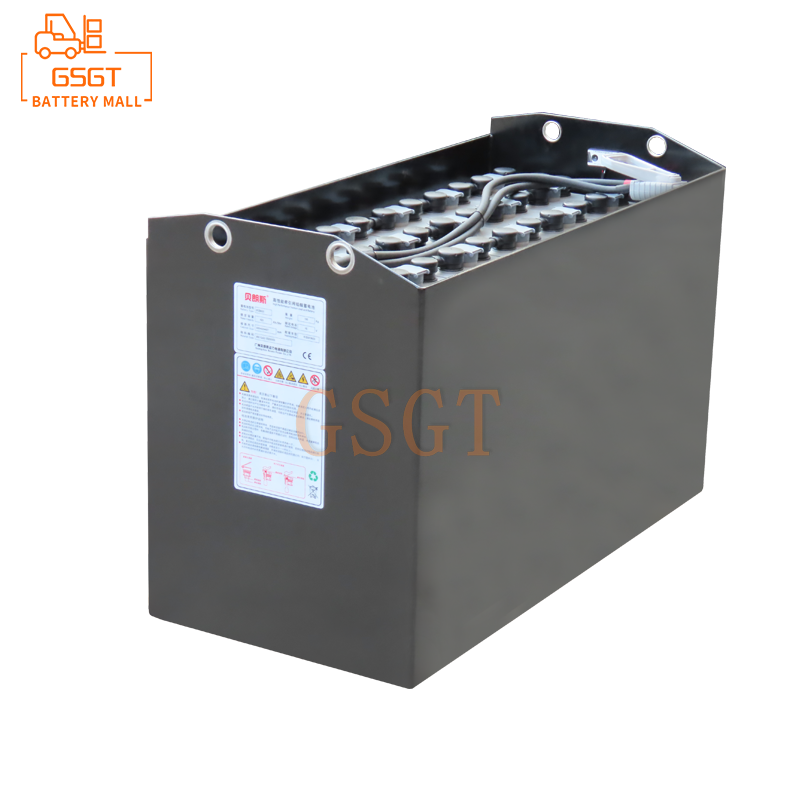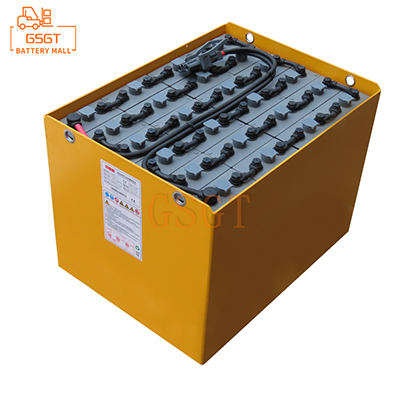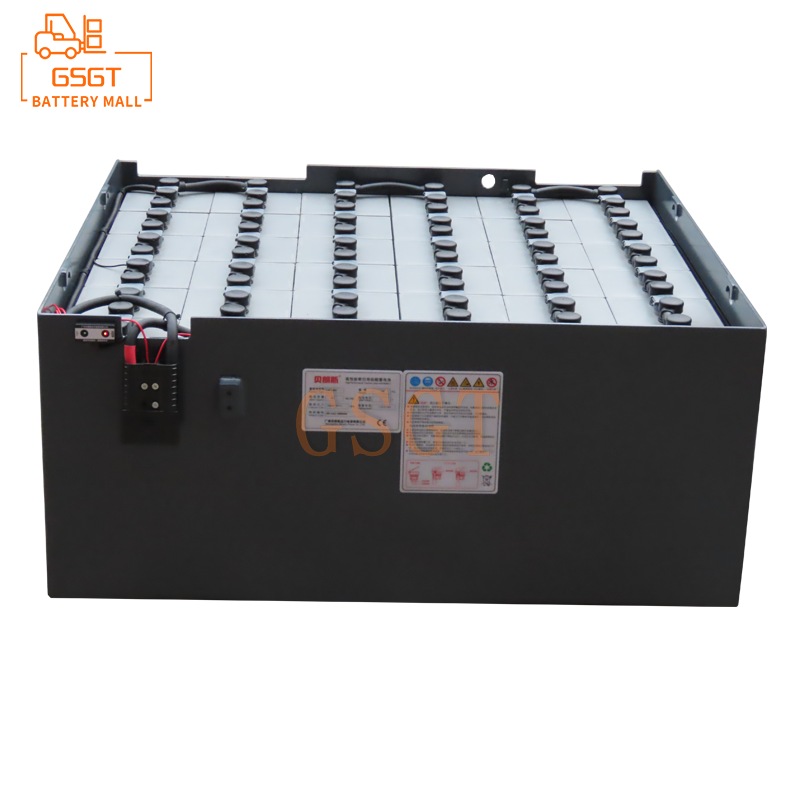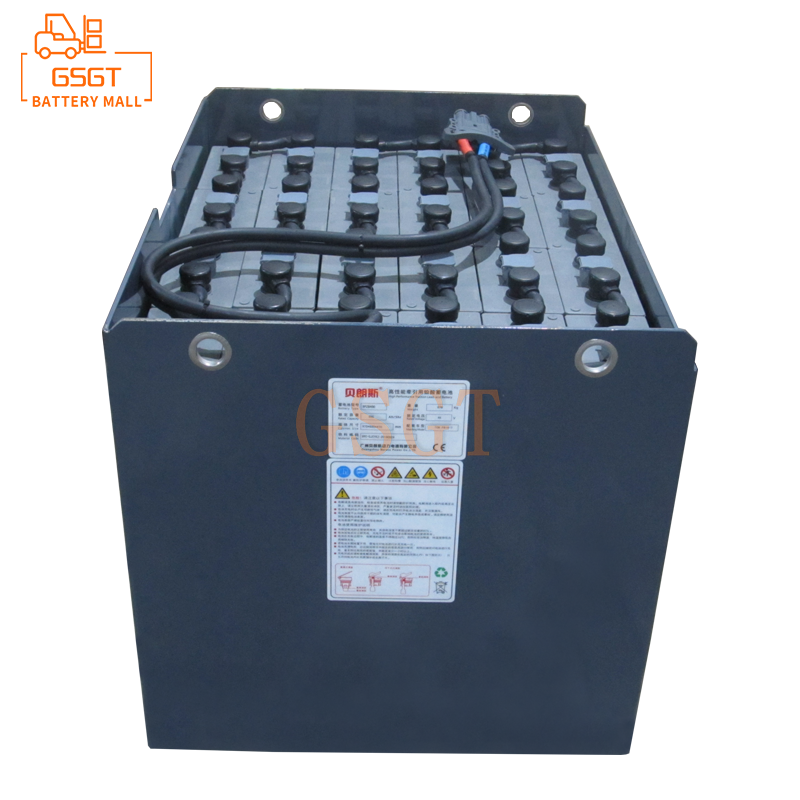Time:2025-05-08 11:35:46
Browse:600
In modern logistics and industrial production, forklifts, as important material handling equipment, the performance of their power sources directly affects work efficiency and operating costs. Lead-acid batteries, as the traditional and widely used power source for forklifts, possess a series of unique key characteristics. These characteristics not only support their stable application in various scenarios but also determine their performance under different working conditions. A thorough understanding of the key characteristics of lead-acid batteries for forklifts is of great significance for enterprises to make reasonable selections, use them efficiently and maintain the power systems of forklifts effectively.
1. Performance Characteristics Analysis
(1) Voltage stability
Lead-acid batteries can maintain a relatively stable voltage output during the discharge process. Under normal discharge conditions, its terminal voltage will gradually decrease as the battery power is consumed, but the decrease process is relatively gentle. This stable voltage output characteristic is crucial for the electrical system and drive motor of forklifts, ensuring that various electronic devices and motors operate stably during operation and preventing excessive voltage fluctuations from affecting equipment performance or causing malfunctions.
(2) Energy Density
The energy density of lead-acid batteries is relatively low, which means that to provide sufficient energy for forklifts to meet their working requirements, battery packs of larger weight and volume need to be equipped. The lower energy density limits the driving range and payload of forklifts, and there is a significant gap in energy storage efficiency compared with some new types of batteries such as lithium-ion batteries. However, in some application scenarios where space and weight restrictions are relatively less strict and cost-effectiveness is emphasized, lead-acid batteries are still widely used due to their mature technology and relatively low cost.
(3) Charging and Discharging characteristics
Charging characteristics: Lead-acid batteries typically adopt a constant current - constant voltage charging method. At the beginning of charging, the battery is charged with a constant current. As the battery voltage gradually increases, when it reaches the set limit voltage value, the charging mode automatically switches to constant voltage charging, and the current gradually decreases until the battery is fully charged. Under normal circumstances, the regular charging time for forklift lead-acid batteries is relatively long, taking about 8 to 10 hours to fully charge the battery from a low level. This may affect the work efficiency of forklifts that need to operate continuously. Therefore, in practical applications, it is often necessary to be equipped with multiple sets of batteries for rotational use. In addition, to extend battery life and prevent overcharging, a dedicated charging control system needs to be equipped to precisely control the charging parameters.
Discharge characteristics: The depth of discharge of lead-acid batteries has a significant impact on their lifespan. Shallow discharge (with a discharge depth of 20% - 30%) is beneficial for extending battery life and allows for multiple charge and discharge cycles. Deep discharge (with a discharge depth exceeding 80%) will accelerate the sulfation of the battery plates and shorten the battery's service life. In the actual operation of forklifts, their load conditions and operating conditions are complex and changeable. Different tasks may lead to different depths of battery discharge. For instance, frequent handling of heavy objects and long-distance driving can deepen the depth of battery discharge. Therefore, rationally planning the forklift operation process and avoiding excessive deep discharge are crucial for maintaining the performance and lifespan of lead-acid batteries.
(4) Cycle life
The cycle life of lead-acid batteries for forklifts is generally around 1,500 times. The specific number of times is influenced by various factors, such as the depth of charging and discharging, charging methods, ambient temperature during use, and maintenance conditions. Under ideal usage conditions, that is, maintaining an appropriate depth of discharge (30% - 50%), adopting the correct charging method and being used at an appropriate ambient temperature (around 25℃), the battery can achieve a relatively high number of cycle life cycles. However, in actual industrial applications, the working environment of forklifts is complex, and it is often difficult to meet the ideal conditions, resulting in the actual cycle life of the battery possibly being lower than the theoretical value. For instance, in a high-temperature environment, the chemical reactions inside the battery accelerate, the evaporation of the electrolyte intensifies, and the corrosion of the plates speeds up, which will significantly shorten the battery's cycle life. In a low-temperature environment, the battery's activity decreases, its internal resistance increases, and its capacity drops, which also affects its cycle life.
3. Structural Design Features
(1) Plate structure
Positive plate: The positive plate of forklift lead-acid batteries mostly adopts a tubular structure. This structure is composed of a framework made of lead alloy and the active substance lead dioxide filled in the framework. The tubular structure can effectively prevent the shedding of active substances and enhance the mechanical strength and service life of the positive plate. During the long-term charging and discharging process, the positive plate is subjected to considerable chemical and mechanical stress. The tubular structure helps maintain the stability of the active material and ensures the stable output of battery performance.
Negative plate: The negative plate is generally of paste type structure, with lead paste evenly coated on the lead alloy grid. The grid design of the negative plate focuses on electrical conductivity and mechanical properties to ensure that electrons can be conducted rapidly during the discharge process, while also withstanding the expansion and contraction stresses during charging and discharging. Compared with the positive plate, the volume change of the active material spongy lead on the negative plate during the charging and discharging process is relatively small. However, a reasonable structural design is still needed to ensure its full contact with the electrolyte and improve the efficiency of the electrochemical reaction.
(2) Electrolyte and Separator
Electrolyte: As the medium for electrochemical reactions, the electrolyte plays a crucial role in lead-acid batteries. Its main components are sulfuric acid and water. The concentration of sulfuric acid is usually between 30% and 40%, and the specific concentration is adjusted according to the battery's usage environment and performance requirements. An appropriate concentration of sulfuric acid can ensure the smooth progress of electrochemical reactions, provide sufficient ion conduction capacity, and enable the battery to stably output electrical energy. During the battery's operation, the water content in the electrolyte gradually decreases due to electrolysis and evaporation, leading to an increase in the concentration of sulfuric acid. Therefore, it is necessary to regularly check and replenish distilled water to maintain the normal concentration of the electrolyte and the battery's performance.
Separator: The separator is located between the positive and negative plates, serving to isolate the positive and negative plates and prevent short circuits. Meanwhile, the separator also has good ion permeability, allowing ions in the electrolyte to pass freely to ensure the progress of electrochemical reactions. The commonly used separator materials for forklift lead-acid batteries include microporous rubber separators, glass fiber separators and plastic separators, etc. These separator materials have a high porosity and chemical stability. They can provide channels for ion transport while ensuring the isolation effect, and remain stable under various working conditions of the battery without undergoing chemical reactions with the electrolyte, thus ensuring the safe and reliable operation of the battery.
(3) Battery casing and connection
Battery casing: The casing of forklift lead-acid batteries is usually made of high-strength and corrosion-resistant plastic materials. These materials have excellent insulation performance and chemical corrosion resistance, which can effectively prevent electrolyte leakage and protect the internal structure of the battery from the influence of the external environment. Meanwhile, the shell design has a certain mechanical strength, capable of withstanding the vibration and impact during the operation of the forklift, ensuring the structural integrity of the battery under harsh working conditions. In addition, the battery casing is usually equipped with handles or slots for easy transportation and installation, facilitating operations during the battery replacement and maintenance of forklifts.
Connection method: Multiple single-cell batteries are connected in series through internal connection strips to form a forklift lead-acid battery pack to achieve the required voltage. The connecting strips are generally made of lead alloy material, which has good electrical conductivity and welding performance, ensuring reliable connection between batteries, low resistance and effective current transmission. In terms of the external connection of the battery pack, dedicated cables and connectors are used to connect with the electrical system of the forklift. The connectors have good plug-and-pull performance and electrical connection stability, preventing the connection from loosening due to vibration during the operation of the forklift and affecting the power supply effect of the battery.
4. Safety and Maintenance Features
(1) Safety considerations
Electrolyte safety: The electrolyte in lead-acid batteries is a sulfuric acid solution, which is highly corrosive. During the use and maintenance of batteries, if electrolyte leakage occurs, it may cause burns to personnel and corrosion damage to surrounding equipment and the environment. Therefore, forklift lead-acid batteries are usually designed with leak-proof devices, such as well-sealed casings and safety valves. When the internal pressure of the battery is too high, the safety valve will automatically open to release the excess gas, preventing the battery from cracking due to excessive pressure. At the same time, it can also effectively prevent the electrolyte from overflowing. In addition, at the installation and usage sites of batteries, necessary protective equipment and emergency response facilities, such as protective gloves, goggles, neutralizers, etc., should be provided to deal with possible electrolyte leakage accidents.
Electrical safety: Lead-acid batteries produce flammable and explosive gases such as hydrogen and oxygen during charging and discharging. If the ventilation in the charging area is poor, these gases will accumulate to a certain concentration and may cause an explosion when exposed to open flames or electric sparks. To ensure electrical safety, the forklift charging area should maintain good ventilation, strictly prohibit fire and smoking, and use explosion-proof electrical equipment. At the same time, the electrical connection of the battery pack should be firm and reliable to avoid short circuits and prevent safety accidents caused by high temperatures and sparks resulting from short circuits. In addition, some advanced lead-acid batteries are also equipped with safety devices such as overcurrent protection and overvoltage protection, further enhancing the electrical safety of the batteries during use.
(2) Key Points for Maintenance
Electrolyte inspection and replenishment: Regularly checking the electrolyte level is an important part of the maintenance of lead-acid batteries. As the battery consumes water during charging and discharging, causing the electrolyte level to drop, when the level is below the minimum mark, distilled water should be replenished in time. Do not add sulfuric acid or other acidic solutions, as this may change the concentration of the electrolyte and affect the battery performance. At the same time, the density of the electrolyte should also be checked regularly. By measuring the density of the electrolyte with a hydrometer, the charging status and health condition of the battery can be determined. Under normal circumstances, the density of the electrolyte in a fully charged battery should be within the specified range. If the density deviates too much, it may indicate that the battery is faulty or undercharged, and further inspection and handling are required.
Plate maintenance: Plates are the core components of lead-acid batteries, and their condition directly affects the battery's performance. During use, it is necessary to avoid overdischarging the battery and keeping it in a state of low power for a long time to prevent sulfation of the plates. Sulfation of the plates will cause a layer of white and hard lead sulfate crystals to form on the surface of the plates, which hinders the progress of electrochemical reactions, resulting in a decrease in battery capacity and an increase in internal resistance. To prevent sulfation of the plates, the battery can be deeply discharged and equalized charged regularly. Deep discharge is to discharge the battery to a relatively low level, but it is important not to exceed the allowable discharge depth of the battery. Equalization charging adopts a special charging method to make the voltage and capacity of each individual cell in the battery pack tend to be consistent, eliminating the imbalance of the plates caused by the differences among individual cells during use and extending the overall service life of the battery.
Cleaning and inspection: Keeping the battery surface clean is crucial for maintaining battery performance and safety. Regularly wipe the battery casing and terminals with a clean damp cloth to remove surface dust, dirt and electrolyte residues, preventing these impurities from causing short circuits in the battery or corroding the terminals. Meanwhile, check whether the battery casing is damaged or deformed, whether the terminal connections are loose, and whether the safety valve is working properly, etc. If any damage to the battery casing is found, it should be replaced in time to prevent the leakage of the electrolyte. Loose terminal connections will increase contact resistance, causing heat generation and power loss. They need to be tightened in time. If the safety valve is blocked or damaged, it should be cleaned or replaced in time to ensure the normal release of the internal pressure of the battery and prevent the battery from bulging or exploding.
5. Cost Characteristics Analysis
(1) Initial procurement cost
Lead-acid batteries have a relatively low initial procurement cost advantage among the power sources of forklifts. Compared with new types of batteries such as lithium-ion batteries, lead-acid storage batteries have mature production processes, a wide range of raw material sources, and relatively low production costs. Take the common lead-acid battery pack used in forklifts as an example. Its price may only be 30% to 50% of that of a lithium-ion battery pack of the same capacity. This enables enterprises to configure the power system at a lower cost in the early stage of forklift procurement. For enterprises with limited budgets or those that are sensitive to costs, lead-acid batteries become an attractive choice. Especially in some small logistics enterprises or projects that use forklifts for a short period of time, the lower initial procurement cost can effectively reduce the initial investment and improve the efficiency of fund utilization.
(2) Usage cost
Energy consumption cost: The energy conversion efficiency of lead-acid batteries is relatively low, generally ranging from 70% to 80%. This means that during the charging process, a considerable portion of the electrical energy is lost in the form of heat energy, etc., resulting in relatively high energy consumption of the forklift. During the long-term usage process, the relatively high energy consumption cost will gradually accumulate, increasing the operational burden on enterprises. Especially in areas with high electricity prices or scenarios where forklifts are used frequently, the impact of energy consumption costs on enterprises' cost control is more significant.
Maintenance cost: As mentioned earlier, lead-acid batteries require regular maintenance, including electrolyte inspection and replenishment, plate maintenance, cleaning and inspection, etc. These maintenance tasks require certain human and material costs. Each maintenance requires professional personnel to spend time on the operation, and it may be necessary to purchase maintenance tools and materials such as distilled water and hydrometers. In addition, due to the relatively short cycle life of lead-acid batteries, they may need to be replaced multiple times during the service life of forklifts, further increasing the usage cost. In contrast, new types of batteries such as lithium-ion batteries have lower maintenance requirements and certain advantages in terms of usage costs in this regard.
(3) Recovery of Cost and value
Lead-acid batteries contain a large amount of recyclable substances such as lead and sulfuric acid. After batteries are scrapped, through professional recycling and treatment, heavy metals such as lead can be recycled and reused. This not only reduces environmental pollution but also has certain economic value. At present, China has established a relatively complete lead-acid battery recycling system, and professional recycling enterprises can effectively disassemble and handle scrapped batteries. Recycling enterprises usually pay a certain recycling fee to the battery owner based on factors such as the weight of the battery and the lead content. To a certain extent, this can make up for part of the battery procurement and usage costs. For enterprises, the rational utilization of battery recycling value is also an important aspect of reducing overall costs. However, it should be noted that improper recycling and processing may lead to environmental pollution and resource waste. Therefore, enterprises should choose regular recycling channels for battery recycling.
In conclusion, forklift lead-acid batteries possess a series of unique key characteristics in terms of working principle, performance, structure, safety maintenance, and cost. These characteristics are interrelated and jointly determine the current application status and development trend of lead-acid batteries in the field of forklift power. Although lead-acid batteries have certain limitations in terms of energy density and cycle life, they still hold an important position in the current forklift market thanks to their mature technology, stable voltage output, low initial procurement cost and recyclability. With the continuous advancement and innovation of technology, lead-acid batteries are also constantly being improved and optimized to better meet the demands of different industries and application scenarios. When enterprises choose the power source for forklifts, they should fully consider these key characteristics of lead-acid batteries, and make reasonable decisions in combination with their actual usage conditions and cost-benefit goals.

$2450

$3405

$4045

$3130

MESSAGE
Professional And Efficient
Security
Affordable Price
Professional Services